Scientists Achieve Breakthrough in Predicting Light Absorption in Complex Semiconductors
Scientists have made a significant breakthrough in understanding and simulating light absorption in complex semiconductor structures. Using advanced microscopy techniques and a new empirical model, they've achieved unprecedented precision in predicting optical transitions.
The team, led by M. H. Alkaisi, employed aberration-corrected scanning transmission electron microscopy to map the detailed composition and strain of epitaxial semiconductor superlattices. This allowed them to develop a generalized empirical model that accurately captures the complex composition of these structures at the atomic level.
Their approach involved detailed modelling of the material composition, accounting for subtle variations at the interfaces between different layers. This proved crucial as the actual structure's energy levels differed significantly from those predicted by a square-band potential model, impacting the absorption spectra.
A key innovation was the use of an aluminum flow modulation scheme during the growth of the thin InAlAs barrier. This, along with growing a specific asymmetric coupled quantum-well structure using a Veeco D180 Turbodisc MOVPE reactor, led to a tenfold improvement in the accuracy of simulating the absorption spectrum of the structure.
The team's work has resulted in a highly accurate method for predicting optical transitions within complex InGaAs/InAlAs semiconductor structures. By precisely modeling the composition of these structures, they've significantly improved the accuracy of light absorption predictions, bringing theory closer to experimental results. The team accurately predicted the E13 transition at 278 meV, closely matching the experimental peak of 281 meV.
Read also:
- Abu Dhabi initiative for comprehensive genetic screening, aiming to diagnose over 800 conditions and enhance the health of future generations in the UAE.
- Elderly shingles: Recognizing symptoms, potential problems, and available treatments
- Protecting Your Auditory Health: 6 Strategies to Minimize Noise Damage
- Exploring the Reasons, Purposes, and Enigmas of Hiccups: Delving into Their Origins, Roles, and Unsolved Aspects





